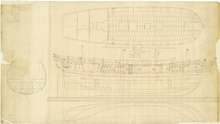HMS Tamar (1758)
HMS Tamar or Tamer was a 16-gun Favourite-class sloop-of-war of the Royal Navy.
%3B_Tamar_(1758)%3B_Flora_(cancelled_1761)_RMG_J4303.png) Tamar | |
| History | |
|---|---|
| Name: | HMS Tamar |
| Ordered: | 11 January 1757 |
| Builder: | John Snooks, Saltash |
| Laid down: | 15 March 1757 |
| Launched: | 23 January 1758 |
| Commissioned: | January 1758 |
| In service: | 1758–1780 |
| Renamed: | HMS Pluto in 1780 |
| Honours and awards: | Battle of Ushant (1778) |
| Captured: | 30 November 1780 |
| Fate: | captured at sea by 24-gun French privateer Duc de Chartres |
| General characteristics | |
| Class and type: | 16-gun Favourite-class sloop-of-war |
| Tons burthen: | 313 15⁄94 (bm) |
| Length: |
|
| Beam: | 27 ft 4 in (8.3 m) |
| Depth of hold: | 8 ft 3 1⁄2 in (2.5 m) |
| Propulsion: | Sail |
| Sail plan: | Ship rig |
| Complement: | 125 |
| Armament: |
|
_RMG_J4559.png)
The ship was launched in Saltash in 1758 and stationed in Newfoundland from 1763 to 1777.
From 21 June 1764 to mid-1766, under Commander Patrick Mouat, she accompanied the Dolphin on a circumnavigation of the globe during which the latter's commander, Capt. Byron, took possession of and named the Falkland Islands in January 1765.[1]

The warship hosted South Carolina's royal governor, Lord William Campbell, beginning in September 1775, when increasingly-violent patriot activity drove the governor from his home on the mainland.[2] She was renamed HMS Pluto when she was converted into a fire ship in 1777. The French privateer Duc de Chartres captured her on 30 November 1780.[3] Her subsequent fate is unknown.[4]
External links

Citations and references
- Citations
- Phillips, Michael. "Tamar". Retrieved 5 June 2016.
- Richard R. Beeman (2013). Our Lives, Our Fortunes and Our Sacred Honor: The Forging of American Independence, 1774–1776. Basic Books. pp. 285–286. ISBN 978-0-465-03782-7.
- Hepper (1994), p.60.
- Demerliac (1996), p.146, #1213.
- References
- Hepper, David J. (1994). British warship losses in the age of sail 1650–1859. Rotherfield: Jean Boudriot. ISBN 9780948864308.
- Winfield, Rif (2007). British Warships of the Age of Sail 1714–1792: Design, Construction, Careers and Fates. Seaforth. ISBN 9781844157006.